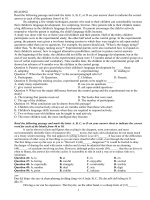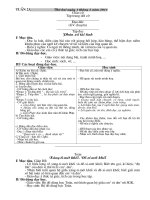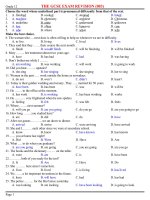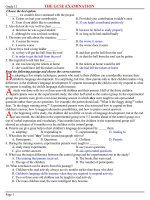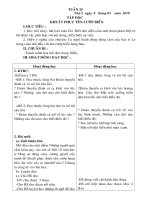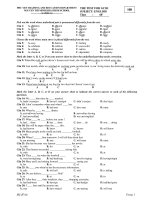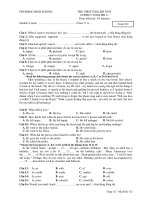- Trang chủ >>
- THPT Quốc Gia >>
- Hóa
GCSE 232
Bạn đang xem bản rút gọn của tài liệu. Xem và tải ngay bản đầy đủ của tài liệu tại đây (73.73 KB, 5 trang )
SƠ GD&ĐT VINH PHUC
TRƯƠNG THPT LIỄN SƠN
(Đề thi gồm: 05 trang)
ĐỀ KSCL ÔN THI THPT QG NĂM HỌC 2019-2020
BÀI THI MƠN: TIẾNG ANH 232
Thời gian làm bài: 60 phút, khơng kể thời gian phát đề
Ho va tên thi sinh:……………………………………………………………………. SBD:…………………………
Mark the letter A, B, C, or D on your answer sheet to indicate the word or phrase that is
OPPOSITE in meaning to the underlined part in each of the following questions.
Question 01: About 95 percent of all animals are invertebrates which can live anywhere, but
most, like the starfish and crabs, live in the ocean.
A. with backbones B. with ribs
C. without ribs
D. without backbones
Question 02: He had never experienced such discourtesy towards the president as it occurred at
the annual meeting in May.
A. politeness
B. rudeness
C. measurement
D. encouragement
Mark the letter A, B, C, or D on your answer sheet to indicate the sentence that best completes
each of the following exchanges.
Question 03. Ken and Laura are saying goodbye to each other after going to LOTTE Center. And
they are going to have a date with each other later.
- Laura. “Well, it’s getting late. May be we could get together sometime.” - Ken: “____________”
A. Nice to see back you.
B. Take it easy.
C. Sounds good. I’ll give you a call.
D. Yes, I’ve enjoyed it.
Question 04. - Waiter: “Can I get you something?” -John: “____________”
A. I’ll pay for what I have eaten
B. Could I have a look at the dessert menu?
C. Yes, you can.
D. Is it cheap or expensive?
Mark the letter A, B, C, or D on your answer sheet to indicate the correct answer to each of the
following questions.
Question 05. Nobody could have predicted that the show would arouse so much interest and that
over two hundred people__________ away.
A. would turn
B. would have turned
C. would have to be turned
D. had been turned
Question 06. No matter how angry he was, he would never__________ to violence.
A. exert
B. resolve
C. resort
D. recourse
Question 07. The effect of the painkiller is__________ and I begin to feel the soreness again.
A. turning out
B. doing without
C. fading away
D. wearing off
Question 08: She has just bought__________.
A. an interesting old French painting
B. an interesting French old painting
C. a French interesting old painting
D. an old interesting French painting
Question 09: It never__________ my head that such a teưible thing would happen.
A. struck
B. dawned
C. occurred
D. entered
Question 10: Sarah and I__________ reserved the rooms in the same hotel. She was really surprised
to see me there
A. coincidentally
B. practically
C. intentionally
D. deliberately
Question 11. We spent nearly 3 hours waiting outside the station, then out__________.
A. the star came
B. did the star come C. came the star
D. under
Question 12. Hats like this may have been fashionable in the 60's, but now they are_________ the times.
A. behind
B. over
C. beneath
D. under
Question 13. My mother often__________ our mistakes, whereas my father is very strict and
punishes us for even the slightest one.
A. neglects
B. overlooks
C. avoids
D. passes
Question 14. Children who are isolated and lonely seem to have poor language and__________.
A. Communicate
B. Communication C. Communicative D. Communicator
Question 15. They worked really hard________ they could earn enough money for their living.
A. so as to
B. because
C. so that
D. in order for
Question 16. “It’s about time you________ your homework, Mary.”
A. must do
B. would do
C. do
D. did
Question 17. In our team, no person________ John could finish this tough task in such a short time.
A. other than
B. apart
C. outside
D. rather than
Question 18. Different people never read a book in___________ same way.
A. a
B. an
C. the
D. 0 (zero article)
Mark the letter A, B, C, or D on your answer sheet to indicate the underlined part that needs
correction in each of the following questions.
Question 19. My father used to give me a good advice whenever I had a problem.
A. used
B. give me
C. a good advice
D. had
Question 20. Thai Nguyen High School is a place in that I used to study when I was a child.
A. in that
B. to study
C. when
D. a child
Question 21. Peter was the first player scored a goal for his team in the yesterday’s match.
A. the
B. yesterday’s match
C. in
D. scored
Mark the letter A, B, C, or D on your answer sheet to indicate the word whose underlined part
that differs from the other three in the pronunciation in each of the following questions.
Question 22. A. touch
B. watch
C. machine
D. armchair
Question 23. A. famous
B. nervous
C. loud
D. serious
Mark the letter A, B, C or D on your answer sheet to indicate the word or phrase that is
CLOSEST in meaning to the underlined part in each of the following questions.
Question 24. At fifty-five, he began life again, determined with his pen to wipe out the debt.
A. rub out
B. pay off
C. bump off
D. give up
Question 25. The National Institute of Mental Health is conducting far-reaching research to
determine the psychological effects of using drugs.
A. refined
B. extensive
C. prevalent
D. tentative
Read the following passage and mark the letter A, B, C, or D on your answer sheet to indicate
the correct answer to each of the questions.
Most forms of property are concrete and tangible, such as houses, cars, furniture or anything
else that is included in one’s possessions. Other forms of property can be intangible, and copyright
deals with intangible forms of property. Copyright is a legal protection extended to authors of
creative works, for example books magazine articles, maps, films, plays, television shows, software,
paintings, photographs, music, choreography in dance and all other forms of intellectual or artistic
property.
Although the purpose of artistic property is usually public use and enjoyment, copyright
establishes the ownership of the creator. When a person buys a copyrighted magazine, it belongs
to this individual as a tangible object. However, the authors of the magazine articles own the
research and the writing that went into creating the articles. The right to make and sell or give
away copies of books or articles belongs to the authors, publishers, or other individuals or
organizations that hold the copyright. To copy an entire book or a part of it, permission must be
received from the copyright owner, who will most likely expect to be paid.
Copyright law distinguishes between different types of intellectual property. Music may be
played by anyone after it is published. However, if it is performed for profit, the performers need to
pay a fee called a royalty. A similar principle applies to performances of songs and plays. On the
other hand, names, ideas and book titles are excepted. Ideas do not become copyrighted property
until they are published in a book a painting or a musical work. Almost all artistic work created
before the 20th century is not copyrighted because it was created before the copyright law was
passed.
The two common ways of infringing upon the copyright are plagiarism and piracy.
Plagiarizing the work of another person means passing it off as one’s own. The word plagiarism is
derived from the Latin plaglarus, which means “abductor”. Piracy may be an act of one person, but,
in many cases, it is a joint effort of several people who reproduce copyrighted material and sell it
for profit without paying royalties to the creator. Technological innovations have made piracy easy
and anyone can duplicate a motion picture on videotape a computer program, or a book. Video
cassette recorders can be used by practically anyone to copy movies and television programs, and
copying software has become almost as easy as copying a book. Large companies zealously
monitor their copyrights for slogans, advertisements, and brand names, protected by a trademark
Question 26. What does the passage mainly discuss?
A. Legal rights of property owners
B. Legal ownership of creative work
C. Examples of copyright piracy
D. Copying creating work for profit
Question 27. The word “principle” in paragraph 3 is closest in meaning to__________.
A. crucial point
B. cardinal role
C. fundamental rule D. formidable force
Question 28. Which of the following properties is NOT mentioned as protected by copyright?
A. music and plays B. paintings and maps C. printed medium D. scientific discoveries
Question 29. It can be inferred from the passage that it is legal if__________.
A. two songs, written by two different composers, have the same melody
B. two books, written by two different authors, have the same titles
C. two drawings, created by two different artists, have the same images
D. two plays, created by two different playwrights, have the same plot and characters
Question 30. With which of the following statements is the author most likely to agree?
A. Teachers are not allowed to make copies of published materials for use by their students
B. Plays written in the 16th century cannot be performed in theaters without permission
C. Singers can publicly sing only the songs for which they wrote the music and the lyrics
D. It is illegal to make photographs when sightseeing or traveling
Question 31. The phrase “infringing upon” in paragraph 4 is closest in meaning to__________.
A. impinging upon B. inducting for
C. violating
D. abhorring
Question 32. The purpose of copyright law is most comparable with the purpose of which of the
following?
A law against theft B. A law against smoking C. A school policy
D. A household rule
Question 33. According to the passage, copyright law is__________.
A. meticulously observed B. routinely ignored C. frequently debated D. zealously enforced
Read the following passage and mark the letter A, B, C, or D on your answer sheet to indicate
the correct answer to each of the questions.
Cooperation is the common endeavor of two or more people to perform a task or reach a
jointly cherished goal. Like competition and conflict, there are different forms of cooperation,
based on group organization and attitudes.
In the first form, known as primary cooperation, group and individual fuse. The group
contains nearly all of each individual’s life. The rewards of the group’s work are shared with each
member. There is an interlocking identity of individual, group and task performed. Means and
goals become one, for cooperation itself is valued.
While primary cooperation is most often characteristic of preliterate societies, secondary
cooperation is characteristic of many modem societies. In secondary cooperation, individuals devote
only part of their lives to the group. Cooperation itself is not a value. Most members of the group feel
loyalty, but the welfare of the group is not the first consideration. Members perform tasks so that they
can separately enjoy the fruits of their cooperation in the form of salary prestige, or power. Business
offices and professional athletic teams are examples of secondary cooperation.
In the third type called tertiary cooperation or accommodation, latent conflict underlies the
shared work. The attitudes of the cooperating parties are purely opportunistic: the organization is
loose and fragile. Accommodation involves common means to achieve antagonistic goals: it breaks
down when the common means cease to aid each party in reaching its goals. This is not, strictly
speaking cooperation at all, and hence the somewhat contradictory term antagonistic cooperation is
sometimes used for this relationship.
Question 34. What is the author’s main purpose in the first paragraph of the passage?
A. To urge readers to cooperate more often
B. To offer a brief definition of
cooperation
C. To explain how cooperation differs from competition and conflict
D. To show the importance of group organization and attitudes
Question 35. The word cherished in paragraph 1 is closest in meaning to__________.
A. defined
B. agreed on
C. prized
D. set up
Question 36. Which of the following is an example of the third form of cooperation as it is defined
in the fourth paragraph?
A. Students form a study group so that all of them can improve their grades
B. Members of a farming community share work and the food that they grow
C. Two rival political parties temporarily work together to defeat a third party
D. A new business attempts to take customers away from an established company
Question 37. Which of the following is NOT given as a name for the third type of cooperation?
A. Tertiary cooperation B. Antagonistic cooperation C. Accommodation D. Latent conflict
Question 38. The word fragile in paragraph 4 is closest in meaning to__________.
A. involuntary
B. poorly planned C. inefficient
D. easily broken
Mark the letter A, B, C, or D on your answer sheet to indicate the word that differs from the
rest in the position of the main stress in each of the following questions.
Question 39. A. zoology
B. conquest
C. cement
D. duet
Question 40. A. photocopy B. particular
C. enthusiasm
D. economy
Read the following passage and mark the letter A, B, C, or D on your answer sheet to indicate
the correct word or phrase that best fits each of the blanks.
Stories about how people somehow know when they are being watched have been going
around for years However, few attempts have been made to investigate the phenomenon scientifically.
Now, with the completion of the largest ever study of the so- called staring effect, there is impressive
evidence that this is a recognizable and genuine sixth sense. The study involved hundreds of children.
For the experiments, they sat with their eyes (41)_________ so they could not see, and with their backs
to other children, who were told to either stare at them or look away. Time and time again the results
showed that the children who could not see were able to tell when they were being stared at. In a total
of more than 18, 000 trials (42)_________ worldwide, the children correctly sensed when they were
being watched almost 70% of the time. The experiment was repeated with the added precaution of
putting the children who were being watched outside the room, (43)_________ from the starters by the
windows. This was done just in case there was some pretending going on with the children telling
each other whether they were looking or not. This (44)_________ the possibility of sounds being
transmitted between the children. The results though less impressive, were more or less the same. Dr.
Sheldrake, the biologist who designed the study, believesthat the result are convincing enough to
find out through further experiments precisely how the staring effect might actually (45)_________.
Question 41. A. shaded
B. covered
C. masked
D. wrapped
Question 42. A. worked over
B. carried out
C. carried on
D. worked through
Question 43. A. parted
B. separated
C. split
D. divided
Question 44. A. prevented
B. omitted
C. evaded
D. ended
Question 45. A. set out
B. be looked at
C. come about
D. be held up
Mark me later A, B, C, or D to indicate the sentence that best combines each pair of sentences
in the following questions.
Question 46. John is studying hard. He doesn’t want to fail the exam.
A. John is studying hard in Oder not to fail the next exam.
B. John is studying hard in Oder that he not fail the next exam.
C. John is studying hard so as to fail the next exam.
D. John is studying hard in Oder to not to fail the next exam.
Question 47. She gave in her notice. She planned to start her new job in January.
A. She gave in her notice, plan to start her new job in January.
B. She gave in her notice with a view to starting her new job in January.
C. Her notice was given in with an aim to start her new job in January.
D. Her notice was given in order for her to start her new job in January.
Mark the letter A, B, C or D on your answer sheet to indicate the sentence that is closest in
meaning to the sentence in italics.
Question 48. When the unemployment rate is high, the crime rate is usually also high.
A. The unemployment rate and the crime rate are both higher.
B. The higher the unemployment rate is, the higher the crime rate is.
C. The unemployment rate is as high as the crime rate.
D The high rate of unemployment depends on the high rate of crime.
Question 49. I wish you hadn't said that.
A. I wish you not to say that.
B. If only you didn't say that.
C. I hope you will not say that.
D. It would be nice if you hadn’t said that.
Question 50. “You're always making terrible mistakes”, said the teacher.
A. The teacher asked his students why they always made terrible mistakes.
B. The teacher realized that his students always made terrible mistakes.
C. The teacher complained about his students making terrible mistakes.
D. The teacher made his students not always make terrible mistakes.
__________HẾT_________
